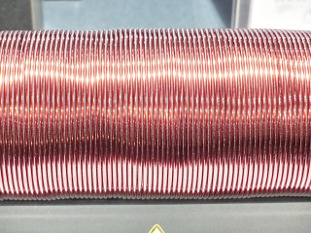Conduction: Difference between revisions
J.williams (talk | contribs) m (1 revision imported) |
energy>Jmdonev No edit summary |
||
| Line 1: | Line 1: | ||
[[Category:Done | [[Category:Done 2018-08-03]] | ||
[[File:copper-wire-113249_640_resized.jpg|frame|right|Figure 1. Common metals, such as copper, display both thermal and electrical conductivity <ref> Pixabay. (2013). ''Copper-wire'' [Online]. Available: http://pixabay.com/p-113249/?no_redirect. </ref>]] | [[File:copper-wire-113249_640_resized.jpg|frame|right|Figure 1. Common metals, such as copper, display both thermal and electrical conductivity <ref> Pixabay. (2013). ''Copper-wire'' [Online]. Available: http://pixabay.com/p-113249/?no_redirect. </ref>]] | ||
<onlyinclude>'''Conduction''' can refer to either: | <onlyinclude>'''Conduction''' can refer to either: | ||
| Line 5: | Line 5: | ||
*[[Electrical conduction]]: the physical property of [[electricity]] moving through material</onlyinclude><ref name = virg> Virginia Universiy. ''Electrical Conduction'' [Online]. Available: http://www.virginia.edu/bohr/mse209/chapter19.htm</ref> | *[[Electrical conduction]]: the physical property of [[electricity]] moving through material</onlyinclude><ref name = virg> Virginia Universiy. ''Electrical Conduction'' [Online]. Available: http://www.virginia.edu/bohr/mse209/chapter19.htm</ref> | ||
The word [[conductor]] usually means a material with high [[electrical conductivity]] (low [[resistivity]]). However, most conductors (usually [[metal]]s), are good thermal conductors as well.<ref name = ecooling> Electronics Cooling. (2000). ''How Thermal Conductivity Relates to Electrical Conductivity'' [Online]. Available: http://www.electronics-cooling.com/2000/05/how-thermal-conductivity-relates-to-electrical-conductivity/</ref> For example, [[copper]] is both an excellent thermal conductor and electrical conductor. | The word [[conductor]] usually means a material with high [[electrical conductivity]] (low [[resistivity]]). However, most electric conductors (usually [[metal]]s), are good thermal conductors as well.<ref name = ecooling> Electronics Cooling. (2000). ''How Thermal Conductivity Relates to Electrical Conductivity'' [Online]. Available: http://www.electronics-cooling.com/2000/05/how-thermal-conductivity-relates-to-electrical-conductivity/</ref> For example, [[copper]] is both an excellent thermal conductor and electrical conductor. | ||
The reverse is usually but not always true;<ref name=ecooling /> for example, diamonds are excellent thermal conductors (even better than copper) but usually [[electrical insulator]]s. Although at very low temperatures a research group found <ref>Ekimov et al., "Superconductivity in diamond" in ''Nature'', Vol. 428, New York: MacMillan, 2004, pp. 542-5. Available: http://www.nims.go.jp/NFM/paper1/SuperconductingDiamond/01nature02449.pdf</ref> showing that diamonds can become [[superconductor]]s below 4 [[Kelvin|K]] (superconductivity is specifically a description of electrical conduction, not thermal conduction). | The reverse is usually but not always true;<ref name=ecooling /> for example, diamonds are excellent thermal conductors (even better than copper) but usually [[electrical insulator]]s. Although at very low temperatures a research group found <ref>Ekimov et al., "Superconductivity in diamond" in ''Nature'', Vol. 428, New York: MacMillan, 2004, pp. 542-5. Available: http://www.nims.go.jp/NFM/paper1/SuperconductingDiamond/01nature02449.pdf</ref> showing that diamonds can become [[superconductor]]s below 4 [[Kelvin|K]] (superconductivity is specifically a description of electrical conduction, not thermal conduction). | ||
==For Further Reading== | |||
*[[Thermal conduction]] | |||
*[[Electrical conduction]] | |||
*[[Conductor]] | |||
*[[Resistor]] | |||
*[[Electrical insulator]] | |||
*Or explore a [[Special:Random|random page]] | |||
==References== | ==References== | ||
{{reflist}} | {{reflist}} | ||
[[Category:Uploaded]] | [[Category:Uploaded]] | ||
Revision as of 21:50, 12 August 2018

Figure 1. Common metals, such as copper, display both thermal and electrical conductivity [1]
Conduction can refer to either:
- Thermal conduction: the physical property of heat moving through material[2]
- Electrical conduction: the physical property of electricity moving through material[3]
The word conductor usually means a material with high electrical conductivity (low resistivity). However, most electric conductors (usually metals), are good thermal conductors as well.[4] For example, copper is both an excellent thermal conductor and electrical conductor.
The reverse is usually but not always true;[4] for example, diamonds are excellent thermal conductors (even better than copper) but usually electrical insulators. Although at very low temperatures a research group found [5] showing that diamonds can become superconductors below 4 K (superconductivity is specifically a description of electrical conduction, not thermal conduction).
For Further Reading
- Thermal conduction
- Electrical conduction
- Conductor
- Resistor
- Electrical insulator
- Or explore a random page
References
- ↑ Pixabay. (2013). Copper-wire [Online]. Available: http://pixabay.com/p-113249/?no_redirect.
- ↑ Boston University. (1998). Heat Transfer, and The First Law of Thermodynamic [Online]. Available: http://physics.bu.edu/~duffy/py105/notes/Heattransfer.html
- ↑ Virginia Universiy. Electrical Conduction [Online]. Available: http://www.virginia.edu/bohr/mse209/chapter19.htm
- ↑ 4.0 4.1 Electronics Cooling. (2000). How Thermal Conductivity Relates to Electrical Conductivity [Online]. Available: http://www.electronics-cooling.com/2000/05/how-thermal-conductivity-relates-to-electrical-conductivity/
- ↑ Ekimov et al., "Superconductivity in diamond" in Nature, Vol. 428, New York: MacMillan, 2004, pp. 542-5. Available: http://www.nims.go.jp/NFM/paper1/SuperconductingDiamond/01nature02449.pdf

